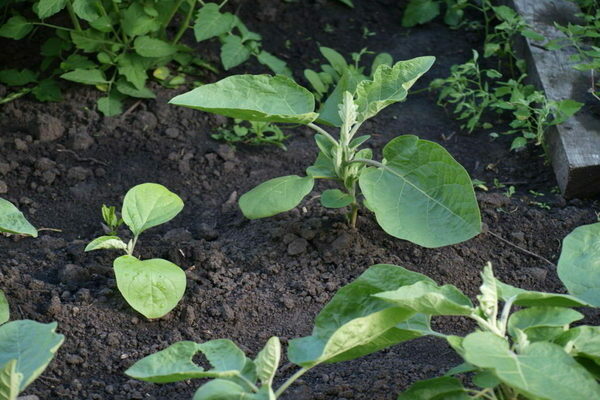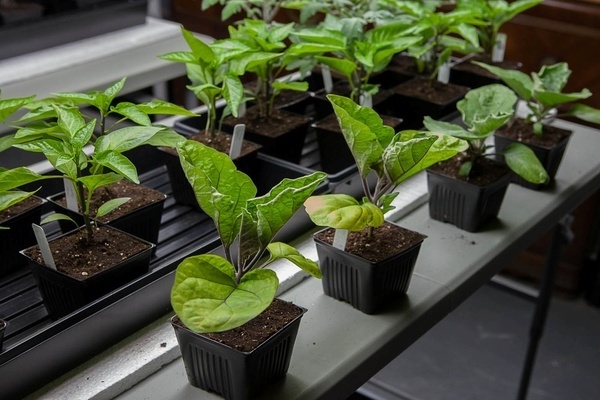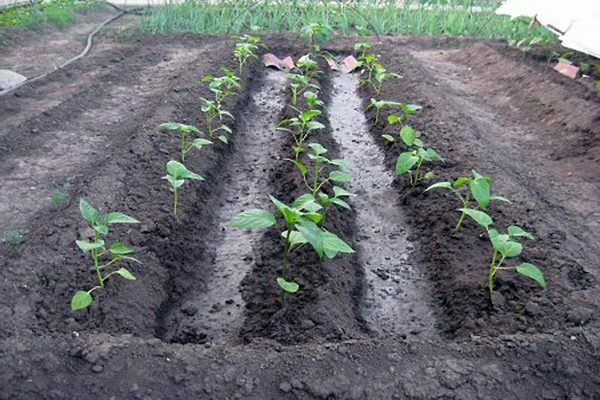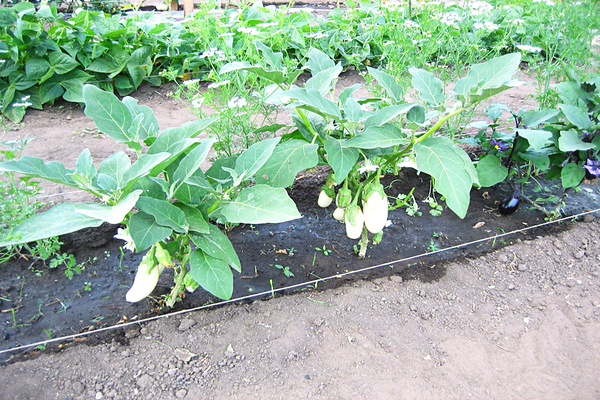Planting scheme eggplant
Content:
The eggplant yield largely depends on whether the agrotechnical rules are followed, but the agrotechnics and planting rules are what depends on the varietal affiliation of the plant. In fact, eggplants are initially considered a rather whimsical culture, which requires special attention and care. Today, eggplants can be grown in various regions and zones, especially when it comes to climatic zones and stripes of our country. But, one way or another, a lot depends on the gardener himself and on whether he will give enough care to the plant, monitor him, his general condition. Planting eggplant is one of the most important stages in growing.
Planting eggplant. Introduction

The homeland of eggplants is India. From there came the plant's requirements to be in warm soil, to be constantly illuminated by the sun. After all, this so affects, in general, what the conditions for the growth and development of eggplant will be. The plant is also very fond of spacious, open spaces. Since its roots can grow over sufficient areas. That is why you should be very careful about the conditions in which the plants will grow, in which area this will happen.
Today, a large number of a wide variety of eggplant varieties have been identified. They all differ from each other in various ways. These are sizes, compact and spreading varieties of different heights. Also, according to the color of the fruits themselves, the speed of their ripening and the requirements in agricultural technology and care measures.
In this article, we will touch on the most significant topic. We will tell you how it is necessary to plant eggplants so that they receive a sufficient amount of nutrients and nutrients and fully develop in the personal plot.
There are several basic eggplant planting schemes that are very popular today. And which are the most basic, if we are talking specifically about the agricultural technology of eggplant. These schemes include such as:
- planting eggplant in the open field;
- planting eggplant indoors;
- planting eggplants by drip irrigation.
We will get to know this type of eggplant planting in more detail within the framework of this article. But first, you also need to dwell in more detail on how to prepare seeds and a site for planting in open ground.
Soil and seed preparation is a very important part. Since the future growth of the plant, its development and, of course, issues related to fruiting largely depend on this. Therefore, it is strictly forbidden to ignore them. And that's why we will just start our article with this.
Preparation of planting material

It should take about two months from the moment the eggplant seeds are sent into the soil until the time the seedlings are planted in open ground. And sometimes about seventy days. The middle zone of Russia, as well as the region of the Moscow region - in these places, seeds must be planted from the end of February to mid-March.
In this case, one should be very careful about the landings. Keep them in the most comfortable conditions so that the seeds germinate and give active growth. And so that by the time of planting, the seedlings look like full-fledged bushes.
Before sowing, the seeds must be prepared in advance. This must be done in the same way as the seed material of many other posadi is prepared.
First, the seeds are carefully selected, disinfected using special means or a solution of potassium permanganate.Then the change is soaked in solutions based on Epin and Zircon. Since these funds are very effective growth stimulants.
After that, it is best to place the seedlings in a darker place where they will actually germinate. These are the very first and basic steps in preparing the seed well and increasing the chances that the seeds will sprout well and vigorously under the conditions created for them.
Planting eggplants in the ground: soil preparation
After the seeds have sprouted, the seedlings dive and further develop to the point that they can be planted in open ground. For this, the soil is prepared in advance.
It must be perfectly structured, ventilated, and also must be simply suitable for an eggplant culture. In this case, the soil will need the most minimal interventions from the gardener himself.
In the fall, it will be necessary to add manure to it, which has already been overheated. And also it is worth adding some mineral additives and fertilizers, which play a very important role in the development of the plant, its green part and the root system.
Fertilizers can be mineral complexes with a high content of phosphorus and potassium. Since it is these components that play, perhaps, the most important role in the development of the plant, its root system, as well as the green part.
If the gardener realizes that the soil on the prepared site does not meet all of the above requirements. It is heavy, practically not ventilated. It must be diluted with some components that will make the soil more conducive to the development and growth of eggplants.
For example, you can mix the soil with river sand or perlite, sawdust. Then it will become less heavy, looser. Fertilizers are also introduced, which we have already mentioned a little above. Only thanks to this, the eggplants will be fed from the soil in the future. And this will be quite enough for them to maintain their normal vital activity, to demonstrate excellent growth rates.
Therefore, the preparation of seeds and soil for planting must be treated very carefully. Thanks to this attentive attitude at the initial stages, in the future, eggplants may not be so whimsical in their care. Since it will be enough for them what the gardener did for them at the very beginning of the care procedures.
Planting eggplants outdoors

Planting eggplant. Planting method - in rows
Seedlings are planted in open ground when the soil after frost has already warmed up, to about +18 degrees. The heating temperature may be slightly lower. But at the same time, there should be guarantees that, after planting in open ground, the seedlings will not undergo return frost, since because of this they may die.
In order for the seedlings to be hardened, it is necessary to take out the boxes with it into an open space. At first, the seedlings can stand no more than one hour, and then the time should be gradually increased.
As a result, before planting, the seedlings should hold out in an open space for about a day. So she will quickly get used to the surrounding conditions. And therefore, he will no longer experience such colossal stress from landing in open ground.
Before planting in open ground, the seedlings are well watered. Also, it must be taken out of the containers very carefully so as not to damage the delicate root system. Next, the seedlings are placed at the bottom of the hole, which is prepared in advance in pre-prepared soil.
Experienced gardeners say it's best not to over-deepen the plant. Otherwise, it will experience noticeable discomfort. That will negatively affect its growth and subsequent development. It is best to plant the plant not in the morning or afternoon, but in the evening, after the sun has begun to hide behind the horizon.
As for the choice of the site, it is not recommended to plant eggplants on the site where other nightshades, potatoes and tomatoes, eggplants, peppers had previously grown and developed. Since they take away a large amount of nutrients from the soil. And it needs enough time (about two years) to recover, and for such demanding crops to grow again on them.
It is best if peas and other legumes, as well as cabbage or cucumbers, root crops, grew on this site before the eggplants. After them, the soil is not so haggard, so it will be easier for eggplants to take root. Eggplants are located on the plots in different ways. It all depends solely on the configuration of the bed itself. And also on what variety the eggplant belongs to, what type of bush and root system, what is the rate of development and ripening of fruits.
Planting eggplant in rows - This is one of the most common types of eggplant planting. Usually landings can be called in this case: one-line, two-line tape, as well as three-line tape.
In all cases, the gardener adheres to his own rules. Since a lot depends on the characteristics of the planting, on the variety and types of eggplant. There may be other ways of planting eggplants. But here a lot depends on the species and variety itself.
One way or another, you can adhere to a single principle of landing. Therefore, it is quite convenient when applied to a wide variety of varieties and types of eggplant. It is necessary to maintain a distance of about 70 centimeters between the rows, at least.
Between plants within one row, you can leave at least 30 centimeters and no more than 40 centimeters. Since the landings should not be too crowded. In principle, observing these rules, you can not worry about the correctness of agricultural planting. And plants will feel as comfortable as possible in such a scheme.
Planting eggplant in a square-nesting way - another type of eggplant planting. This option does have many advantages, as it allows the plants to coexist with each other without shading each other. Therefore, fruiting will be more favorable and abundant. But it should be borne in mind that much depends on what species the plant belongs to. And therefore, here we will mention the following:
- tall bushes, which are large in size, must be planted with each other, taking into account the planting according to the scheme of 60x60 or 70x70 centimeters. So they will get along well with each other;
- undersized and small-fruited plants can be planted a little closer to each other - at a distance of 40x40 centimeters, or half a meter by half a meter;
- if the varieties belong to the category of medium-sized, then they can be planted, taking into account the indicators of both the first scheme and the second. They will be equally suitable and relevant and the plants will feel equally comfortable. One way or another, it is still recommended to keep a longer distance. Because in this case, the comfort of the root system will be ensured, it will develop more actively.
After the seedlings have been planted in a square-nested way, they must be well moistened. To do this, use warm, settled water. And also a very weak solution of potassium permanganate is introduced under each bush. To once again disinfect the soil and root system.
Before the eggplants finally take root, they need to be kept in partial shade. Since direct sunlight can negatively affect the plant itself. They can also damage delicate leaves that need time to adapt to planting conditions.
While the plant has not fully rooted and adapted, it is also recommended to cover it overnight to protect the plant from night frosts and from the stress it still experiences from entering a new environment.
Planting eggplant in greenhouse conditions

Planting eggplant in a greenhouse: two-row method
In general, planting seedlings in greenhouse conditions is practically no different from planting eggplant seedlings in open ground. But the difference lies solely in the timing when the finished seedlings are planted in a special room.
As a rule, seedlings can be planted in a greenhouse 14 to 28 days earlier than if this planting was carried out in open ground. So the timing should be periodically moved, taking into account the general condition of the plant. There are several basic schemes for planting a plant in greenhouse conditions, which we will now discuss in more detail.
The first method is called single row... Low-growing eggplants can be planted up to forty centimeters apart. For medium-sized eggplants, this distance increases to half a meter. But tall plants must be planted at a distance of about 60 centimeters.
Planting an eggplant in two rows way. There should be a distance of 50-70 centimeters between the rows, no more, but no less. It is best if, in this case, the eggplants are staggered. This way they will not cast shadows on each other. And also in general, the root system and the upper part of the plant will develop well.
Depending on the size, it is also necessary to consider what the planting scheme will be. Plants can be short or tall and oversized. Therefore, when planting eggplants, one should take into account how intensively the plant grows. And also take into account the peculiarities of the location of the plant in greenhouse conditions.
Planting eggplant with drip irrigation it is also worth following some landing rules. The drip system is designed for those crops that prefer moist soil more. And they also have an excellent relationship directly to moisture. When planting seedlings, it is necessary to take into account some conditions and features:
- when the eggplants are placed in narrow rows, one narrow ribbon can be used to irrigate the bushes. The tape is usually placed either along a row with eggplant bushes, or a little closer to the stems themselves;
- middle rows need ribbons on both sides. So there is a greater chance that the plant will receive comprehensive moisture. And in the future it will give excellent results;
- if the beds differ in their vastness, then usually there are three rows there. And a drip tape is installed there, especially along each selected row.
Frequent mistakes

There are several mistakes when planting eggplants. And now we will tell you more about how to avoid them. Of course, mistakes can occur both among inexperienced gardeners and those who have devoted many years to this occupation, and now it is imperative for him to correct it.
In order to avoid mistakes in the future and get an excellent and high-quality, tasty harvest, you must follow some rules.
The most common mistake is that the seedlings are not so strong, and besides, they also managed to stretch out. The reason is that the crops are too close together, or the planting was simply not done correctly.
Therefore, eggplants can initially be planted in a separate container. And then, already as it grows, some bushes are removed, dive. This is the only way to reduce the risk of diseases of the seedlings themselves, which, at the same time, are already experiencing considerable stress.
The planting scheme must also be followed when planting seedlings. In general, eggplant is a vegetable that anyone who loves delicious vegetables can enjoy. But at the same time, they still need to be looked after in order to get a sufficient harvest.
By following the planting scheme, you can get excellent vegetables that will be stored for a long time. And they will also be able to carry long-distance transportation over long distances.
By following the planting pattern, you can get excellent results.The bushes will receive the amount of nutrients and lighting that they actually need. The gardener will also need to feed the bushes, care for them, and loosen the ground around the plantings. And even here it will be useful to follow the planting scheme in order to protect the plant from any mechanical damage.
This will create great and attractive shrubs that will have the same attractive vegetables with excellent taste.

